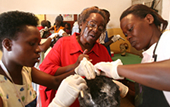What work have you done for AMREF’s Outreach Programme?
I joined AMREF as the Outreach Manager for the Programme in November 2003. During my tenure, I have overseen the expansion of outreach in terms of number of hospitals and number of patients benefiting. Due to funding from FDSA, outreach has tripled in their projects (FDSA used to give 4 M in funding every year, and now they give about 14 M per year). We were only visiting a total of 35 hospitals in Kenya and Tanzania, but currently we go to over 150 hospitals in 8 countries. Outreach has grown from USD 700,000 in 2003 to USD 4M currently.
What are the key milestones for the Outreach Programme?
Expansion of outreach meant more funding and this was made possible after FDSA tripled their funding and our budget as well. VVF development centres were set up (e.g. in Kenyatta National Hospital) for reconstructive surgery, and Dr. Khisa (who is in charge of VVF) was hired and in turn trained a lot of doctors. About 5 hospitals used to be visited in Muhimbili (Tanzania) and now we visit 15 hospitals. From 2007, 1,000 patients get treated as compared to 200 and 300 from previous years. Not only do we repair a huge number of recently acquired Fistuli, but also Fistuli from decades ago.
What is the current VVF prevalence? Give statistics.
An obstetric Fistula is the most devastating of all pregnancy related injuries and affects more than 100,000 African women each year. It is estimated that there are over 5,000 VVF cases reported in East Africa each year. This condition mostly affects poor women and girls who cannot afford skilled supervised health facility delivery. Over 90% of the cases are caused by difficult and prolonged obstructed labour. At Kenyatta National Hospital alone, 400 cases are reported each year.
What more do you feel can be done?
I feel that we need to prioritize disability repair and rehabilitation in both women and children. Because of distance, especially in reaching those who have no access to proper healthcare, we have to fly to reach our patients and that is very expensive as our programmes mainly depend on donors and well wishers. In addition, the population in Kenya has multiplied and exceeds economic growth. Demand for healthcare is therefore much higher. If the government was to pay for health insurance (about Kshs. 2,000 per family), then majority would have access to clinics.
If given the ability, what would you change?
If given the capacity, I would invest in more reproductive health programmes which in turn would help reduce Fistula. These programmes include training (Midwives), Family Plannning and Ante-natal services, among others.
Which programmes or areas of intervention would you introduce if given the resources?
As mentioned earlier, there is a need to prioritize more on disability repair and rehabilitation in women and children. These areas include injuries, congenital malformations, burns, Cleft lip, Fistula and maternal child health.
What is your vision for the VVF programme?
Unfortunately, VVF is there to stay in Africa. Because of poor healthcare, many women are delivering at home. Fistula repair will continue to contribute to better quality of life and empowerment for the disadvantaged women of Kenya and Africa. There is a need to not only sustain the Fistula programme, but to also expand it. Currently, we are being invited to go to Mogadishu, Somali land, South Sudan, among other countries. The number of repairs awaiting reconstruction in Mogadishu alone is thousands, while there is no money (1 repair costs USD 300). Fistula repair is women’s empowerment-the, most important empowerment opportunity to offer women.
VVF FACTS
Vesico-Vaginal Fistula is an abnormal connection between the urinary bladder and the vagina, the result being constant leakage of urine. Recto-Vagina Fistula is an abnormal communication between the rectum and the vagina, the result being leakage of stool. These patients smell of urine or stool all the time. An obstetric Fistula is the most devastating of all pregnancy related injuries and affects more than 100,000 African women each year. It is estimated that there are over 5,000 VVF cases reported in East Africa each year. This condition mostly affects poor women and girls who cannot afford skilled supervised health facility delivery. Over 90% of the cases are caused by difficult and prolonged obstructed labour. Their pain is constant, and their shame makes them outcasts in the society. Most of the time, the child they struggled so hard to deliver will be still born.
At Kenyatta National Hospital alone, 400 cases are reported each year, with AMREF being the only organization which is currently involved in the surgical treatment of VVF patients in East Africa (since 1992) through their Outreach Programme. FDSA has been funding the Fistula repair activities-an initiative that restores the dignity of the affected women and improving their lives.
To learn more about the outreach programme click here














